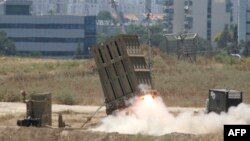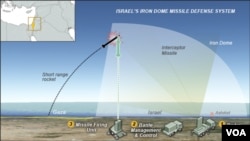A U.S. Senate defense subcommittee has voted to double funding for Israel’s Iron Dome missile defense system. The Pentagon originally requested $175 million for Iron Dome, but if the new bill passes, Israel would receive more than $350 million.
That’s good news for Israel—and for American defense contractors slated to receive more than half those funds to co-produce more Iron Dome units. But critics question such big spending on a system they say doesn’t live up to its glowing reputation.
A clever system
Iron Dome was developed after Israel’s second war with Lebanon in 2006, when about 4,000 rockets were fired from southern Lebanon.
“What is special about Iron Dome is that it’s the only one of its kind,” said Jeremy Binnie, Middle East/Africa editor for IHS Jane’s Defense Weekly.
“It’s the only missile interception system which is designed to intercept short-range rockets. And that is largely because of the relatively unique situation that Israel has found itself in, where it has had this particular threat both coming from Gaza and from Hezbollah in southern Lebanon,” he said.
Iron Dome consists of several units, or batteries. It is not clear how many batteries are currently deployed.
“Because of operational considerations, we unfortunately can't elaborate about the number,” Israeli Defense Force spokeswoman Libby Weiss told VOA in an email.
Israel said it would need as many as 15 batteries to fully protect its citizens from attacks by Hamas and Hezbollah in Lebanon.
Each battery is a cluster of three transportable components: a computerized radar detection and tracking unit; a management and control unit; and a box launcher, outfitted with about 60 missiles called interceptors. These can be moved and positioned wherever they are needed.
It’s an expensive system. Each battery costs about $50 million. Each interceptor costs as much as $100,000.
Here’s how it is designed to work.
The detection and tracking unit uses radar to scan a defined area for any incoming short- to medium-range rockets, that is, coming from up to about 43 miles away. A separate control unit consists of computers and other high-tech instruments that quickly analyze the radar’s data.
“The Iron Dome is very clever, in that its radar can see a rocket coming and very quickly calculate whether that rocket will be landing in a populated area and could threaten life,” Binnie said. “It makes those calculations in a matter of seconds and launches the intercept at anything it determines is a threat.”
Defining ‘success’
Here’s where things can get tricky, says Theodore Postol, a physicist and missile-defense expert at the Massachusetts Institute of Technology. In order to be effective, the interceptor has to be able to hit the incoming rocket head-on and destroy the actual warhead, i.e., explosive material loaded onto its front tip.
“The only way the Iron Dome interceptor can tell where the front of the artillery rocket is by illumination,” Postol said. “A ‘laser fuse’ projects a set of light beams toward the artillery rocket, which reflects light.”
After a slight delay, says Postol, the Iron Dome interceptor detonates a cylindrical-shaped bomb comprised of multiple rods. These should disperse into blow fragments into both the incoming rocket and its warhead, destroying both.
But a lot can go wrong during that delay between detonation and impact, says Postol. By examining the “contrails”—those plumes of smoke in the sky seen in videos of Iron Dome interceptions from 2012 on through to recent weeks—he and other scientists say that Iron Dome misses the mark more often than not.
“The rocket will still go on to the ground and the warhead will still explode,” he said. “So the only meaningful definition of ‘intercept’ in this circumstance is destruction of the warhead. And sometimes people have incorrectly argued that if they hit the incoming artillery rocket, they divert it. But that’s also not true.”
“The Iron Dome success rate is roughly 90 percent,” said Israeli Defense Force spokeswoman Libby Weiss in an email.
But it’s hard to tell what that figure actually means. Has Iron Dome destroyed the warheads of 90 percent of the rockets Hamas has fired? Or has the defense system merely intercepted the rockets without destroying the warheads?
VOA posed that question to Weiss.
“The Iron Dome Air Defense system has been incredibly successful in preventing death and unimaginable destruction all over Israel,” was her emailed reply. “Hamas is launching rockets with the goal of terrorizing and targeting Israel's civilian population and Iron Dome has played a central role in safeguarding Israel's civilians.”
Postol says that he believes the interception rate could be more like 5 percent, and he says he should know.
“Remember, I was the guy who showed that the 96 percent intercept rate claimed for the Patriot missile in the Gulf War of 1991 was instead probably zero, and pretty much everybody now accepts that finding,” he said.
If he is correct, how is it that only one Israeli has died?
According to the Israeli Home Front website, the rockets being fired into Israel carry a relatively small amount of explosives which can damage buildings and injure people out in the open. But thanks to a sophisticated civil defense system that includes shelters in every building and a sophisticated early warning system, Postol says most Israelis are able to quickly get out of harm’s way.
As for Binnie, he says Israel is “firing a very expensive system in order to intercept a very cheap threat,” adding, “It would be nice to have a lot more information so that people have a better idea of what’s going on here.”










